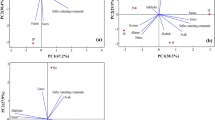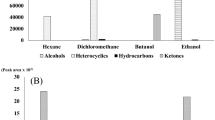Abstract
Aroma compounds of commercial cider vinegars according to their acidity (low, moderate, double-strength, and triple-strength) were comparatively investigated. SPME/GC-MS analysis revealed 8 types of aroma compounds commonly existing in the vinegar including acetic acid. A cider vinegar with moderate acidity showed the most volatile profiles. Electronic nose analysis suggested that the peak at 0.40 s was a component related to total acidity of vinegar. Principal component analysis enabled e-nose to discriminate easily by presenting the separated position depending on total acidity. Significant differences with the acidity were observed in the pungent odor intensity and odor preference. According to the results, the moderate acidity vinegar was revealed to retain most volatile profiles and sensory odor. Compared to sensory evaluation, the analysis using SPME/GC-MS and e-nose provided more distinct patterns on their volatile compounds depending on their acidity, which might be a potential tool in determining the volatile profiles of cider vinegars.
Similar content being viewed by others
References
Mazza S, Murooka Y. Vinegar through the age. pp. 17–39. In: Vinegars of the World. Solieri L, Giudici P (Eds.) Springer, NY, USA (2009)
Ou ASM, Chang RC. Taiwan fruit vinegar. pp. 223–241. In: Vinegars of the World. Solieri L, Giudici P (Eds.) Springer, NY, USA (2009)
FDA homepage. http://www.fda.gov/ICECI/ComplianceManuals/CompliancePolicyGuidanceManual/ucm074471.htm Accessed Sep. 2, 2013.
Lee YC, Lee JH. A manufacturing process of high-strength vinegars. Food Industry and Nutrition 5: 13–17 (2000)
Ubeda C, Callejón RM, Hidalgo C, Torija MJ, Mas A, Troncoso AM, Morales ML. Determination of major volatile compounds during the production of fruit vinegars by static headspace gas chromatography-mass spectrometry method. Food Res. Int. 44: 259–268 (2011)
Su MS, Chien PJ. Aroma impact components of rabbiteye blueberry (Vaccinium ashei) vinegars. Food Chem. 119: 923–928 (2010)
Morales ML, González GA, Casas JA, Troncoso AM. Multivariate analysis of commercial and laboratory produced Sherry wine vinegars: Influence of acetification and aging. Eur. Food Res. Technol. 212: 676–682 (2001)
Callejón RM, Tesfaye W, Torija MJ, Mas A, Troncoso AM, Morales ML. Volatile compounds in red wine vinegars obtained by submerged and surface acetification in different woods. Food Chem. 113: 1252–1259 (2009)
Signore AD. Chemometric analysis and volatile compounds of traditional balsamic vinegar from Modena. J. Food Eng. 50: 77–90 (2001)
Blanch GP, Tabera J, Sanz J, Herraiz M, Reglero G. Volatile composition of vinegars. Simultaneous distillation-extraction and gas chromatographic-mass spectrometric analysis. J. Agr. Food Chem. 40: 1046–1049 (1992)
Giordano L, Calabrese R, Davoli E, Rotilio D. Quantitative analysis of 2-frufural and 5-methylfurfrural in different Italian vinegars by headspace solid-phase microextraction coupled to gas chromatographymass spectrometry using isotope dilution. J. Chromatogr. A 1017: 141–149 (2003)
Cocchi M, Durante C, Grandi M, Manzini D, Marchetti A. Threeway principal component analysis of the volatile fraction by HSSPME/GC of aceto balsamico tradizionale of modena. Talanta. 74: 547–554 (2008)
Castro RM, Natera RM, García VM, García CB. Optimization of headspace solid-phase microextraction for analysis of aromatic compounds in vinegar. J. Chromatogr. A 953: 7–15 (2002)
Morales ML, Benitez B, Troncoso AM. Accelerated aging of wine vinegars with oak chips: evaluation of wood flavor compounds. Food Chem. 88: 305–315 (2004)
Zhang Q, Zhang S, Xie C, Fan C, Bai Z. ‘Sensory analysis’ of Chinese vinegars using an electronic nose. Sensor. Actuat. B-Chem. 128: 586–593 (2008)
Tesfaye W, Garcia-parrilla MC, Troncoso AM. Sensory evaluation of sherry wine vinegar. J. Sens. Stud. 17: 133–144 (2002)
Anklam E, Lipp M, Radovic B, Chiavaro E, Palla G. Characterization of Italian vinegar by pyrolysis-mass spectrometry and a sensor device (‘electronic nose’). Food Chem. 61: 243–248 (1998)
Pizarro C, Esteban-Díez I, Sáenz-González C, González-Sáiz JM. Vinegar classification based on feature extraction and selection from headspace solid-phase microextraction/gas chromatography volatile analyses: A feasibility study. Anal. Chim. Acta 608: 38–47 (2008)
Desrochers R, Keane P, Ellis S, Dowell K. Expanding the sensitivity of conventional analytical techniques in quality control using sensory technology. Food Qual. Pref. 13: 397–407 (2002)
Tesfaye W, Morales ML, Benitez B, Garcia-Parrilla MC, Troncoso AM. Evolution of wine vinegar composition during accelerated aging with oak chip. Anal. Chim. Acta 513: 239–245 (2004)
Wilson AD, Baietto M. Application and advance in electronic nose technologies. Sensors. 9: 5099–5148 (2009)
SAS Institute Inc. SAS User’s Guide. Statistical Analysis System Institute, Cary, NC, USA (1990)
Yoon HN. Moon SY, Song SH. Volatile compounds and sensory odor properties of commercial vinegars. Korean J. Food Sci. Technol. 30:299–305 (1998)
In HY, Lee TS, Lee DS, Noh BS. Volatile components and fusel oils of sojues and mashes brewed by Korean traditional method. Korean J. Food Sci. Technol. 27: 235–240 (1995)
The Merck (index). An Encyclopedia of Chemicals, Drugs, and Biologicals. 13th ed. Merck & Co., Inc. Whitehouse station, NJ, USA (2001)
Lee SW, Yoon SR, Kim GR, Woo SM, Jeong YJ, Yeo SH, Kim KS, Kwon JH. Effects of Nuruk and fermentation method on organic aid and volatile components in brown rice vinegar. Food Sci. Biotechnol. 21: 453–460 (2012)
Capone S, Tufariello M, Francioso L, Montagna G, Casino F, Leone A, Siciliano P. Aroma analysis by GC/MS and electronic nose dedicated to Negroamaro and Primitivo typical Italian Apulian wines. Sensor. Actuat. B-Chem. 179: 259–269 (2013)
Sim C, Ahmad M, Ismail Z, Othman A, Noor N, Zaihidee E. Chemometric classification of herba Orthosiphon stamineus according to its geographical origin using virtual chemical sensor based upon fast GC. Sensors 3: 458–471 (2003)
Nurjuliana M, Che Man YB, Mat Hashim D, Mohamed AKS. Rapid identification of pork for halal authentication using the electronic nose and gas chromatography mass spectrometer with headspace analyzer. Meat Sci. 88:638–644 (2011)
Noh BS, Oh SY, Kim SJ. Pattern analysis of volatile components for domestic and imported Angelica gigas Nakai using GC based on SAW sensor. Korean J Food Sci. Technol. 35: 144–148 (2003)
Jo D, Park EJ, Kim GR, Yeo SH, Jeong YJ, Kown JH. Quality comparison of commercial cider vinegars by their acidity levels. Korean J. Food Sci. Technol. 44: 699–703 (2012)
Author information
Authors and Affiliations
Corresponding author
Rights and permissions
About this article
Cite this article
Jo, D., Kim, GR., Yeo, SH. et al. Analysis of aroma compounds of commercial cider vinegars with different acidities using SPME/GC-MS, electronic nose, and sensory evaluation. Food Sci Biotechnol 22, 1559–1565 (2013). https://doi.org/10.1007/s10068-013-0251-1
Received:
Revised:
Accepted:
Published:
Issue Date:
DOI: https://doi.org/10.1007/s10068-013-0251-1




